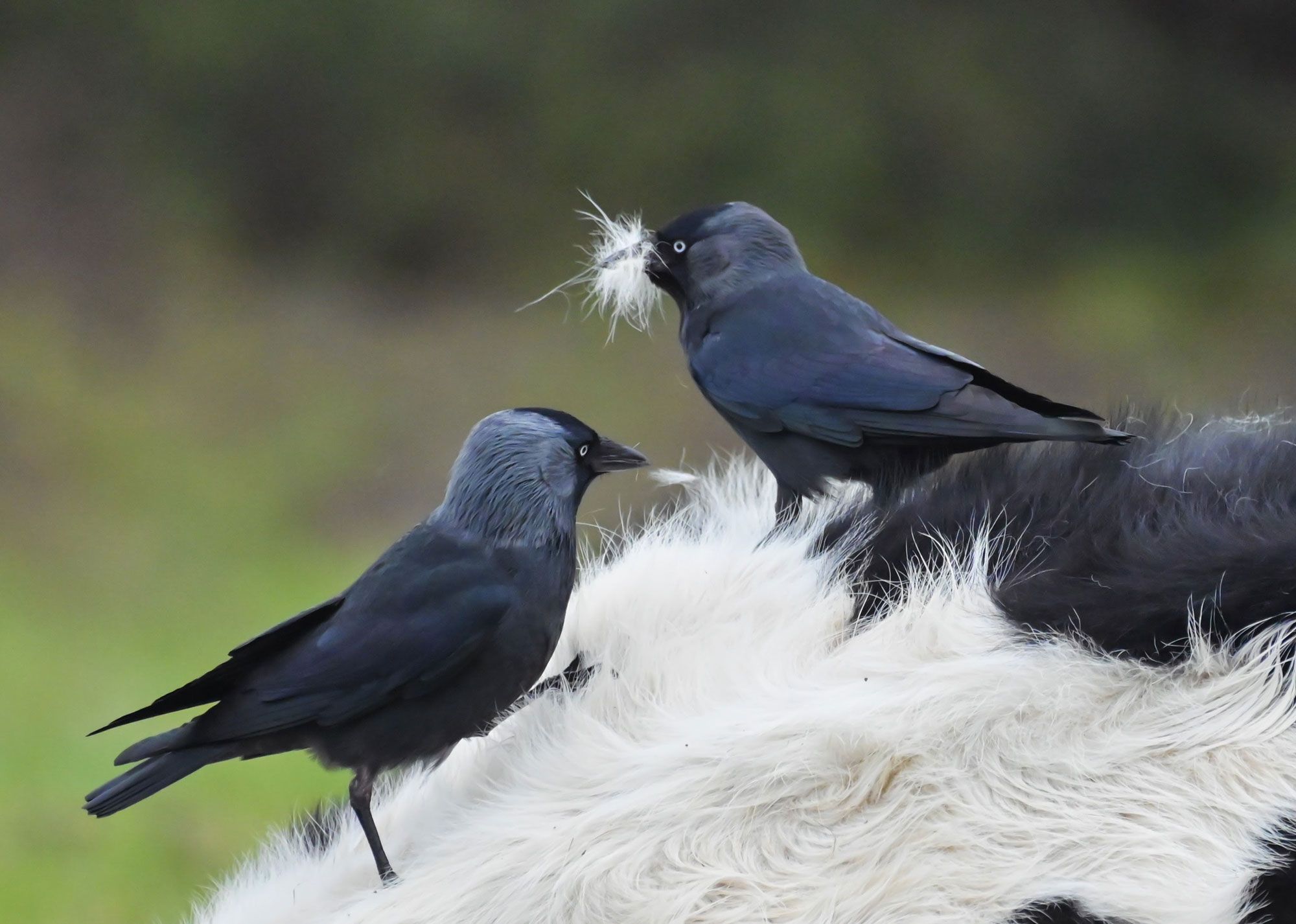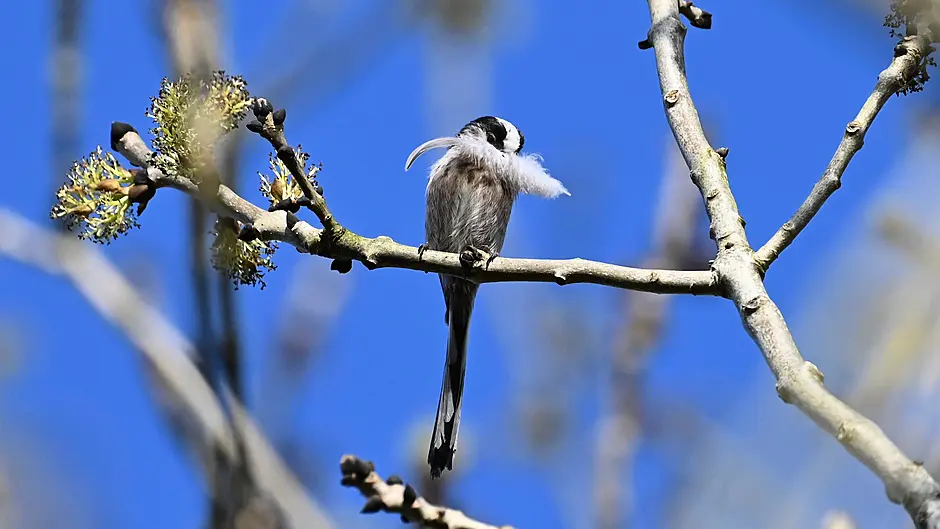BY ANN HAIGH
IN recent weeks, we have started to spot various bird species beginning their nesting activities. It is a delight to watch them energetically flying by, with their beaks laden with nesting materials.
An amusing sight was a rook struggling to carry twigs longer than their own body. Another highlight was witnessing a heron gracefully glide past us near Union Hall, clutching a large stick in its elongated bill. Herons are known for nesting early, gathering in groups called heronries and refurbishing their nests from the previous year during February and March.
Nest locations
Nests exhibit a remarkable diversity in both form and location. Some birds, such as blue tits, nest in tree cavities, while others, like puffins, utilise abandoned rabbit burrows.
House martins and swallows prefer man-made structures such as building eaves, while kingfishers and sand martins excavate burrows in sandy banks. Terns and plovers simply scrape a hollow in the ground.
Ground-nesting birds typically rely on camouflaged eggs and chicks to conceal their nests from predators. However, nesting on the ground poses increased risks, particularly due to human activity.
Risky spots
Species like the curlew and corncrake, which rely on ground nests, have experienced significant declines. For example, the corncrake nests in long grass, and its steep decline has been linked to the mechanisation of mowing and the shift from hay to silage production.
Despite a 96% decline since the 1970s, significant conservation efforts have led to a recovery in the north west of the country. Last year, a corncrake was recorded on the Aran Islands for the first time in 25 years, and the number of breeding territories increased by 35% compared to five years earlier, a cause for cautious optimism if protection continues.
Nesting materials
Many birds are resourceful and use readily available materials to construct their nests. For instance, blue tits typically line their nests with feathers but will use wool if sheep are nearby.
Birds exhibit a wide range of nesting habits: bullfinches fashion loose nests from twigs and sticks, while goldfinches and chaffinches create tighter nests using moss, lichen, and line with hair and feathers. Linnets and warblers weave their nests from grass and plant materials.
Other birds, however, are specialists that require specific nesting materials, such as house martins and swallows. These birds use existing hard structures and buildings as their base but rely on mud as a critical nesting material. They collect this from nearby rivers, streams, ponds, and puddles. Both male and female house martins collect mud in their beaks and mould it into soft pellets to construct the nest. Long-tailed tits make one of the most intricate and beautiful nests in Ireland. They are constructed from lichen, moss and cobwebs and lined with up to 1,500 feathers.
Strange habits
Some birds have particularly unusual nesting practices. One of the most remarkable is the cuckoo, which, of course, does not build a nest at all. Instead, they lay their eggs in the nests of unsuspecting birds, notably meadow pipits, a behavior known as brood parasitism. The cuckoo relies entirely on other bird species to brood and rear their young.
Jackdaws are cavity nest builders, using natural cracks, crevices and often chimneys. They construct the base structure using larger items like twigs and sticks, then line it with grass, fur or hair. Sadly, with the ever-increasing level of pollution and litter, both terrestrial and sea birds are increasingly using our waste materials to build their nests.
Last year, we were astonished to witness jackdaws in Innishannon collecting cigarette butts for their nests. Studies have revealed that birds have adapted to use these to reduce insect parasites in their nests because the chemicals in cigarettes repel them.
Robins, known for their lack of shyness around people, nest in unconventional places near human habitation. In addition to trees, hedges and bushes, their nests can be found in unusual places such as watering cans, plant pots, gates and garden sheds.
 Jackdaws seen on Céim Hill last month collecting hair for their nest from an obliging cow. (Photo: Nick Haigh)
Jackdaws seen on Céim Hill last month collecting hair for their nest from an obliging cow. (Photo: Nick Haigh)
Protections
Several legal protections are in place to safeguard nesting birds. As per the Wildlife Act, it is prohibited to remove or damage the nest of any wild bird while it is being built or in use. Additionally, from March 1st to August 31st, it is illegal to cut, grub, burn, or otherwise destroy vegetation growing in any hedge or ditch to protect birds and their nests.
It is worth noting that photographing or filming nesting birds without a specific licence from the National Parks and Wildlife Service is also illegal. This last measure might seem surprising, but it aims to prevent disturbance to nesting birds, and specifically applies to those on or near nests containing eggs or unflown young.
How to help
There are several ways to support nesting birds. Firstly, and most importantly, refrain from cutting trees and bushes during the spring and summer months. Instead, consider planting new trees and bushes to provide birds with nesting sites and materials.
Another beneficial step is to install nest boxes in your garden, or even incorporate specific structures like ‘swift bricks’ into walls, enabling swifts to nest within them. Additionally, young fledgling birds are particularly vulnerable, so if you spot them in your garden, keeping your dogs and cats indoors for a few days can allow them crucial time to find their feet (and wings!).
There is something very wholesome and heartwarming to see birds collecting nesting materials to prepare for their eggs and chicks. They are currently very busy with this activity, so keep your eyes peeled.








